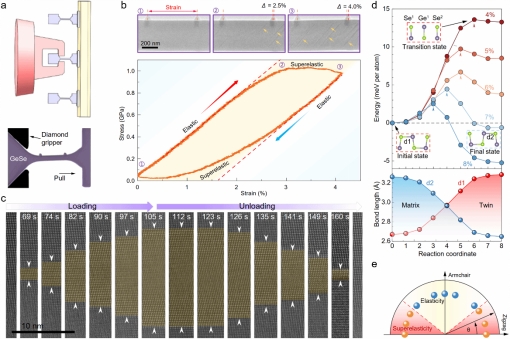The research team led by Academician Tian Yongjun from the State Key Laboratory of Metastable Materials Science and Technology at YSU, in collaboration with Professor Yuan Hongtao’s team from Nanjing University and Professor Wang Hongtao’s team from the Center for X-Mechanics of Zhejiang University, has discovered for the first time superelasticity behavior induced by reversible deformation twinning in layered semiconductors (Figure 1). The findings, titled “Reversible Shuffle Twinning Yields Anisotropic Tensile Superelasticity in Ceramic GeSe,” were published online in Nature Nanotechnology on April 10, 2025.
Historically, the understanding of crystal deformation mechanisms has been primarily derived from studies of metals and their alloys. However, due to the high strength, directionality, and electron localization characteristics of covalent bonds, the deformation mechanisms in covalent crystals may significantly differ from those in metallic crystals. Unfortunately, the deformation mechanisms of covalent crystals and their relationship with mechanical properties have long remained unclear. Following their research on deformation twinning in purely covalent crystals (Nature Materials Volume 24, 361–368, 2025), Academician Tian Yongjun’s team conducted tensile tests on GeSe, a layered crystal with mixed covalent-Van der Waals bonding, and observed its deformation process at atomic resolution (Figure 2). The research revealed that when tensile strain reaches a critical threshold, stripy twin domains form within the GeSe crystal, which then completely vanish upon unloading, demonstrating remarkable reversibility. This phenomenon aligns with the nonlinear characteristics in the stress-strain curve and the hysteresis in loading-unloading cycles, which are typically indicative of superelastic behavior.
Further research has revealed that the formation of these twins is mediated by a bond-breaking and reformation mechanism: under tensile strain, out-of-plane Ge-Se bonds rotate, while in-plane Ge-Se bonds undergo breaking and reformation, ultimately facilitating twinning. This mechanism is distinctly different from the dislocation-based mechanisms in traditional metallic crystals. The superelasticity induced by reversible twinning in GeSe exhibits unique advantages, including uniform strain distribution, no volume change, and a maximum tensile strain of up to 12.8%, which surpasses the performance of conventional martensitic phase-transformation-induced superelastic materials. Moreover, the superelasticity occurs only within a ±30° range along the zigzag direction, demonstrating significant directional selectivity and providing greater flexibility for performance tuning. The study also found that reversible twinning-induced superelasticity observed in GeSe appears to be fairly universal among group IV-VI layered semiconductor materials. This research extends the field of superelasticity beyond traditional martensitic phase transformations, introducing a new mechanism of reversible twinning mediated by chemical bond reconstruction. This offers a fresh perspective for exploring novel superelastic materials and deformation mechanisms.

Figure 1. Schematic illustration of reversible twinning-induced superelastic behavior in layered semiconductor GeSe

Figure 2. Reversible twinning-induced superelasticity in GeSe.
(a) Tensile testing of GeSe; (b) Stress-strain curve during the loading-unloading process and the formation of twin domains; (c) Evolution of twin domains observed via high-resolution transmission electron microscopy; (d) Energy and bond-length changes during twinning transformation under different strains; (e) Angular range within which superelasticity is observed
This study was a collaborative effort between YSU, Nanjing University, and Zhejiang University. The co-first authors of the paper are Wang Chong, Li Zeya, and Cheng Yingchun, while the corresponding authors are Weng Xiaoji, Yuan Hongtao, and Nie Anmin. The project is funded by the National Natural Science Foundation of China (52288102, 52090022), the Natural Science Foundation of Hebei Province (E2024203054, E2022203109), and other programs.